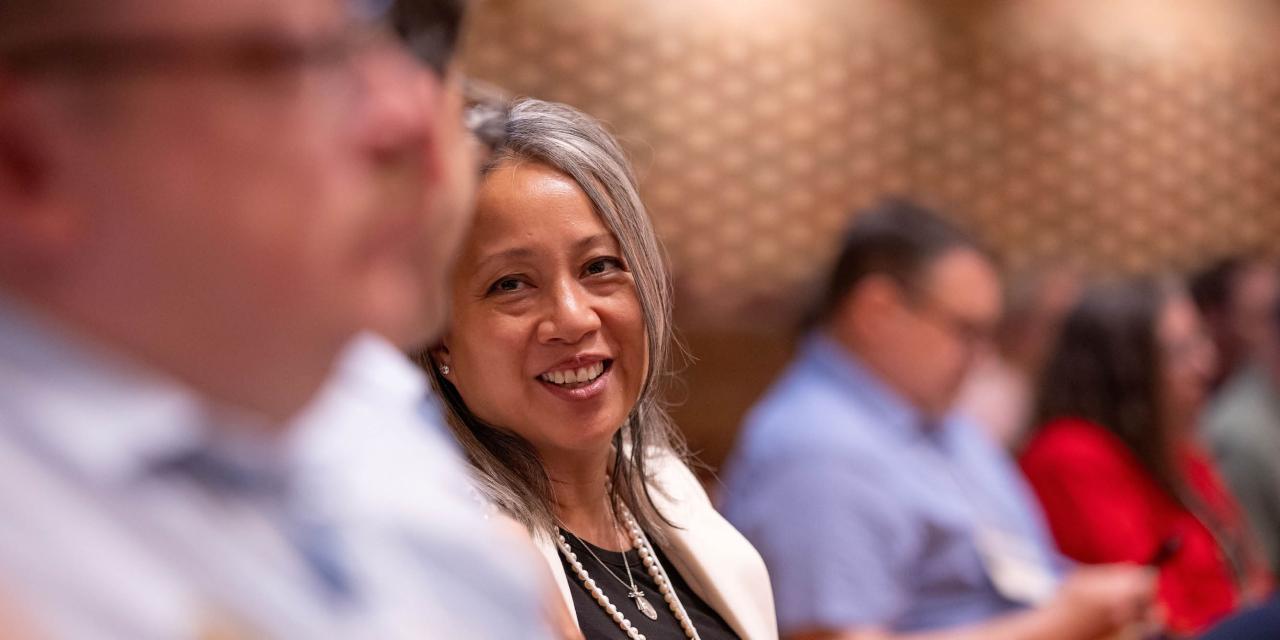Mimi L. Larson specializes in children’s faith formation. She has directed church children’s ministries and coedited Bridging Theory and Practice in Children’s Spirituality: New Directions for Education, Ministry, and Discipleship. Larson teaches at Wheaton College and Trinity Evangelical Divinity School in metro Chicago and serves on the Children’s Spirituality Summit board of directors. She is the children’s ministry catalyzer for the Christian Reformed Church in North America. In this edited conversation, she discusses initial research for her Vital Worship Teacher-Scholar Grant on how children make meaning of their worship experiences.
What is your teacher-scholar grant’s purpose, and who is the audience?
I seek to understand how experienced ministry leaders thoughtfully engage preschool through elementary-age children in worship experiences. I’m researching how churches encourage children in authentic worship experiences, how children experience worship, and how the community nurtures, encourages, and shapes a child’s faith through worship. I address these questions from three perspectives—developmental, theological, and pedagogical—to learn how each influences how children make meaning of their worship experiences.
My two primary audiences for this research are ministry leaders within the local church as well as seminary and college professors who teach and train those who will work in the local church. I intend that leaders will be able to apply my findings to their unique contexts.
Can you describe faith development from a developmental perspective?
I use the faith development paradigm that John H. Westerhoff described in his seminal work Will Our Children Have Faith?. This faith paradigm traces four styles of faith: experienced faith, affiliative or belonging faith, questioning faith, and owned faith. In a lifelong faith development process, children participate in the first two styles—experienced faith and belonging faith. Adolescents and adults participate in questioning faith and ultimately, we hope, come to an “owned” faith. Westerhoff uses the metaphor of tree rings to describe these styles. Each style builds on the next and is necessary for our faith development. By comparison, some faith-stage theorists describe individuals leaving stages and moving on from them.
What do experienced faith and belonging faith look like in children?
Westerhoff’s high view of children and how their faith is formed is essential to understand why it is important for children to engage in authentic worship experiences. As Westerhoff describes it, we first learn faith as an affective experience, not as a theological affirmation. So in experienced faith, the first style, we learn what love is by how we experience love around us. We experience faith by acting it out through actions and responses to the actions around us. How children participate in and experience worship shapes their faith, understanding, and engagement with God. These experiences are foundational to our faith.
Affiliative or belonging faith is part of childhood and early adolescence. In this style, children seek to act with others in an accepting community with a clear sense of identity. As we find our place within a community (a community of other “faithing selves”), we have a need to belong. Belonging comes through being welcomed and encouraged to actively participate and contribute to a community where we are wanted, needed, accepted, and belong. From this place we internalize our faith community’s understandings and beliefs. This style of faith also impacts how children engage with God.
How does church theology affect the faith development process in children?
This grant project looks at churches with sacramental, covenantal, or conversional theology. Those terms come from the book Children Matter: Celebrating Their Place in the Church, Family, and Community. The authors explain that our theological convictions definitely impact how we approach ministry with children. For instance, if a conversional church is concerned with a child praying a certain prayer so that they become Christian, they will teach and provide activities towards that end. If a church believes a child is baptized as a covenant child, their aims and goals will be different.
The easiest example of these differences shows up in curriculum structure. When developing a curriculum, what story do we tell first? What is emphasized and reemphasized? What are the essential themes and messages that we want children to hear? Do we start with our sin or God’s love? This sounds simplistic, but it has great consequences in how children experience God and live out our faith.
What was your original research plan?
I planned to visit six Protestant churches for four or five days each. I chose two sacramental churches, two covenantal churches, and two conversional churches. I planned to do ninety-minute interviews with pastors and children’s ministry leaders to explore their beliefs about children and worship and their methods for engaging children in thoughtful worship.
I also planned to observe children’s worship in each church and do follow-up interviews about what I observed. The three theological strains helped me structure my research sample. I’m looking for differences in what churches value and prioritize and how they engage children in worship.
How did the coronavirus change your research plan?
I was on my third research visit when the governor of Illinois started making plans to issue shelter-in- place orders. As I was finishing my interview with a church in Pennsylvania, they decided to close the church on Sunday. So I was able to visit three different churches face to face, but not observe children in the third church. I used Zoom to interview people at the last three churches in my research sample. I asked them to share materials and pictures or videos so I can understand and observe as much as I can in a COVID-19 world.
The pandemic gave me opportunity to purposely expand my research sample. The first six congregations in my research project came from my network of best practices in children’s ministry. I realized that five of these churches are very white, and only one church is more diverse. Because my travel has been restricted, I’ve had time to look for three to six more diverse churches to expand my research sample. It is my hope to be able to interview these churches in the near future.
How did you deal with these changes?
Attending the June 2020 Vital Worship Grants event was so helpful as I heard that other teacher-scholars and worshiping communities had also had their projects turned upside down. Hearing their stories allowed me to become creative with my project. I’m deeply grateful to the Calvin Institute of Christian Worship because it values worship and ministry with children.
What have you learned so far?
Across North America, churches often remove children from worship to receive biblical education or “age-appropriate” worship. Yet worship is one of our primary callings as a Christian community. Because children are full image-bearers of God, individuals in whom God is seeking to be in relationship with, the better question is asking how to teach, engage, and encourage children to worship.
My research is showing me there’s not just one way to engage children in authentic worship. Depending on the context, churches are using a multiple of different practices. The key thing I’m finding is that you have to allow children to be children and believe that children have the capacity to worship.
Can you give examples of contrasting approaches that nevertheless nurture children in worship?
Two churches I’m studying use the arts as a way for children to express and interact with God. One does this through a children-only Sunday evening arts program. The other church includes children in the large intergenerational service. This church creates tangible, tactile experiences that all people can do. During Lent they set up a table to create butterflies during worship. The Easter plan was to suspend the butterflies from the church ceiling to symbolize resurrection. Experiences like these disrupt the normal way to do worship services, because they give everyone a chance to come as they are and contribute within the community, not just receive. The butterfly activity worked well because the church has a history of creating together in worship.
Another church I interviewed is very traditional. Setting up a paint table there wouldn’t fly. However, they created a “prayground.” Parents can sit in pews, while children sit in front of them on child-sized furniture. Worship leaders engage children in learning about what’s in the sanctuary and why. There are sermon-related activities for kids. Worshipers can see kids singing along and raising their hands in praise. One church hands out worship bags with journals and instruction on how to actively listen.
Among the research sample churches that have children step out to worship separately, one uses a chapel that feels like child-sized sacred space. It’s not child-centric or run by children, but there’s a very high view of children, as in “We know God will meet our children. We just have to create an environment.”
How has COVID-19 changed children's worship experiences?
I need to go back to the first three churches I interviewed to learn how their ministries have changed. I want to ask how they are engaging children in worship during a COVID-19 world. Are children a priority for churches? And what might change when the pandemic is less of an issue? From my conversations with other churches, I am finding that engaging children in online worship has been very challenging.
Most churches that have switched to virtual worship don’t have Sunday school. In the butterfly church, it’s because they already believe that children are a vital part of the worshiping community. They want children to grow in faith by experiencing worship as belonging. They reach out to kids by naming them in the virtual service and suggesting sermon-related items for them to gather.
Churches that had been using Godly Play or Young Children in Worship may do the story by video, but it’s definitely not the same as doing it in person. One church has talked about doing socially distanced visits with kids so that they will still feel embedded in the community. The program-related churches are wrestling with how to deliver content. In all cases, it’s helping to use old-fashioned methods like phone calls, visits, and letters to kids and families.
LEARN MORE
Consider applying to the Calvin Institute of Christian Worship's Vital Worship Grants Program, either as a teacher-scholar or a worshiping community. Read Bridging Theory and Practice in Children’s Spirituality: New Directions for Education, Ministry, and Discipleship, edited by Mimi L. Larson and Robert J. Keeley. Check out resources Larson recommends for children’s ministry. Learn how to foster kids’ love for Scripture in ways that cultivate an authentic relationship with God.

